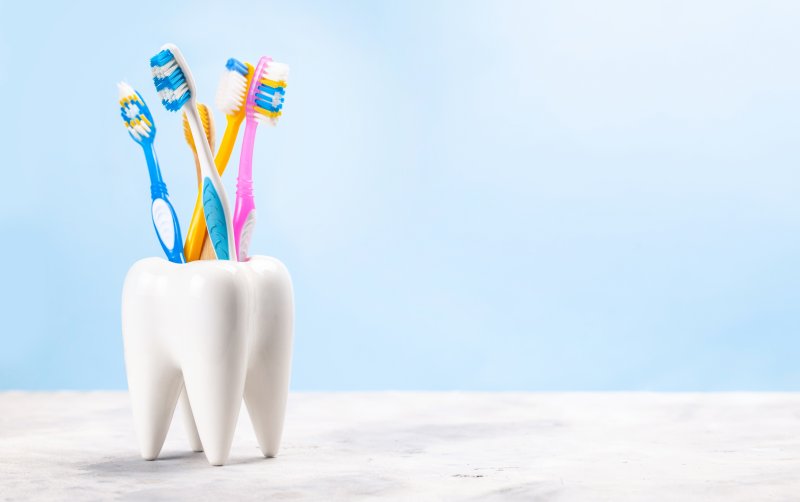
Have you been using the same toothbrush for six months… or more? Do you remember the last time you bought a new one? If you said yes to the first question, then it’s likely you don’t remember when you purchased your most recent toothbrush. Surprisingly, these simple teeth cleaners should be replaced quite often if they are to do their job.
But how do you know which type of brush to buy that will safely and effectively keep your smile decay and disease-free? Before you grab the first one you see on the shelf, consider the following information and use it to help you select the best toothbrush for your needs.
Why Should I Replace My Toothbrush?
The American Dental Association (ADA) and your dentist recommend that you change out your toothbrush every three to four months. The bristles can become frayed or bent and ineffective at removing bad bacteria from your mouth. Also, over time, germs will begin to accumulate, especially if you are sick, and can re-enter your oral cavity, making you more susceptible to tooth decay, gum disease, and bad breath. The bristles of a new brush are straight and point in some organized pattern. If the bristles of your brush are bent and disorganized, it’s time for a new brush!
What Kind of Toothbrush is Right for Me?
There are two toothbrush types, both of which are great for removing harmful plaque and tartar as well as food particles from your mouth. Knowing which one is right for you depends on your needs and personal preference.
If you want a brush that does most of the work for you, requires little effort on your part, and can even keep track of how long you’ve been brushing, opt for an electric toothbrush. These are considerably more costly than manual ones, but they are great for:
- Young children who need assistance to effectively clean their teeth thoroughly
- Individuals with minimal manual dexterity. It is a great solution if you struggle to brush properly because of problems existing in your hands, wrists, or arms. (i.e. senior citizens)
- Individuals who prefer the comfort and ease that an electric toothbrush can provide.
Manual toothbrushes are more commonly found in stores and more prominently displayed. If you are more price-conscious and prefer to keep with the regular method of brushing, a manual brush can still remove bad bacteria and food particles from your mouth. You will need to keep track of how long you are brushing (i.e. timer, stopwatch), and you will need to make sure you are applying just enough pressure to effectively reach all areas of your mouth.
Keep in mind, there are three types of toothbrush bristled: soft, medium, and firm. You want the soft one. If you feel like a soft brush isn’t stiff enough, check with your dentist or hygienist before opting for a stiffer one. Proper technique should allow a soft brush to do the best job for you.
Whether you use a manual or electric brush, pay attention to brushing the tooth right where it meets the gums.
What About the Handle and Bristle Design?
Apart from the type of toothbrush and its bristles, you will also need to consider their design and which handle will fit your grip comfortably.
There are flat, dome, angled, and rippled bristles, but don’t worry, the design and shape aren’t as important as the type of bristles – opt for soft. The shape and design will simply allow you to determine which works best for your mouth, with length of the head probably being most important.
The handle, however, should be comfortable when holding. While you may prefer a blue or green toothbrush instead of a pink or red one, aesthetics have no health benefits. If you want a handle that has a nonslip grip or is flexible when moving throughout your mouth, make sure to read the label and look for one that matches your criteria.
Your hygienist or dentist can always provide helpful recommendations when it comes to determining the right toothbrush for your mouth. If you’re unsure and need assistance, don’t be afraid to call their office or ask during your next dental appointment.
About the Author
Dr. L. Blaine Kennington graduated from the University of North Carolina School of Dentistry in Chapel Hill. For 12 years, he served as a dentist in the United States Air Force, completing a residency in Advanced Education in General Dentistry from 1994-1996. Opening his practice in 2002, he has been helping Castle Rock residents ever since. He and the team at Cowlitz River Dental are pleased to help smiles of all ages, even your family’s youngest, most vulnerable smile. Providing helpful patient education to both children and adults, we can make sure your oral health is equipped with the right tools and techniques to keep your smile looking and feeling its best between appointments. For questions about when you should change out your toothbrush or other at-home oral care tips, visit our website or call (360) 274-9100.
